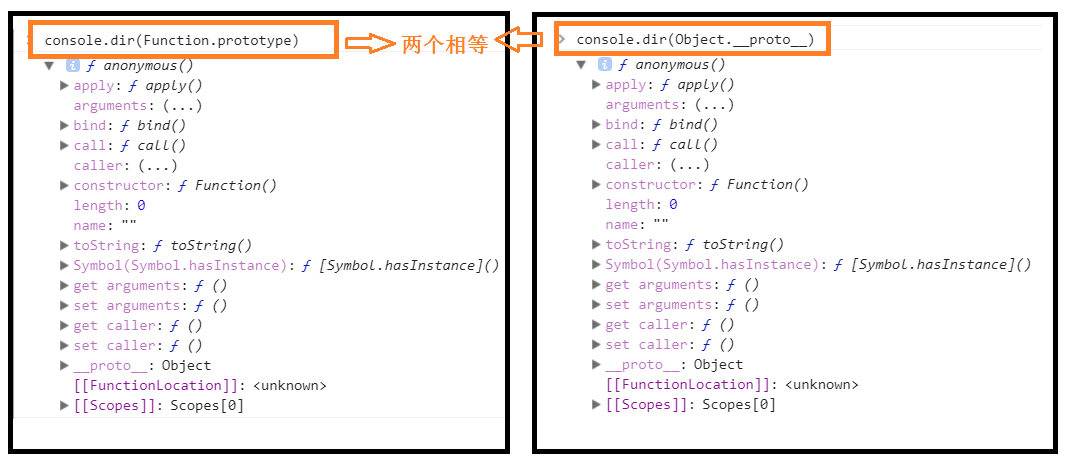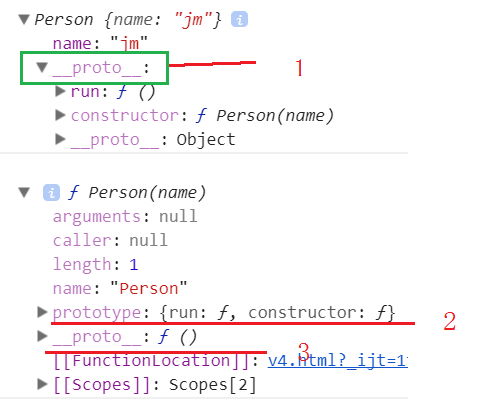一、二者定义
prototype:显式原型(explicit prototype)
- 每一个函数在创建之后都会有
prototype这个属性,这个属性指向函数的原型对象。- 通过
Function.prototype.bind方法构造出来的函数是个例外,它没有prototype属性。
__proto__:隐式原型(implicit prototype)
js中任意一个对象都有一个内置属性[[prototype]],在ES5之前没有标准的方法访问这个内置属性,但是大多数浏览器都支持通过__proto__来访问Object.prototype这个对象是个例外,它的__proto__值为null
二、二者关系
- 二者关系:隐式原型指向创建这个对象的函数(
constructor)的prototype
三、作用
- 显式原型的作用:用来实现基于原型的继承与属性的共享。
- 隐式原型的作用:构成原型链,同样用于实现基于原型的继承。
四、__proto__的指向
4.1 基础理解
- 上面说到:隐式原型(
__proto__)指向创建这个对象的函数(constructor)的prototypejs中创建对象有三种方式:
- 对象字面量
new的方式Object.create()
- 三种方式的本质都是通过
new来创建对象。
- 字面量只是一个语法糖,便于开发者更方便创建对象,为对象添加属性、方法。
- 而
Object.create(),可先看下面的代码(就是Object.create()的实现):
function inherit (obj) {
const F = function () {}
F.prototype = obj
return new F()
}
- 由上述代码,看出
inherit函数最终还不是通过new返回一个对象。接着上面的代码,再看一下以下的输出结果:- demo
function Blue () {}
console.log(inherit({}))
console.log(new Blue())

- 从图中发现:通过
inherit,即Object.create()所创建的对象是没有构造函数(constructor)的。
- 或许你会有一个疑问,既然没有构造函数,那么其
__proto__指向哪里?其实这里说它没有构造函数是指在Object.create()函数外部我们不能访问到它的构造函数,然而在函数内部实现中是有的,它短暂地存在了那么一会儿(即:当new F ()时,其内部的 构造函数F就会被销毁了)。假设我们现在就在函数内部:
// 伪代码如下:
const f = new F ()
// 有
f.__proto__ === F.prototype // true
// 又因为
F.prototype === obj // true
// 所以
f.__proto__ === obj // true
4.2 proto 的指向
function Fun () {}
const fun = new Fun()
// fun 的 __proto__ 指向其构造函数 Fun 的 prototype
console.log(fun.__proto__ === Fun.prototype) // true
// Fun 的 __proto__ 指向其构造函数 Function 的 prototype
console.log(Fun.__proto__ == Function.prototype) // true
// Function 的 __proto__ 指向其构造函数 Function 的 prototype 【 构造函数自身是一个函数,他是被自身构造的】
console.log(Function.__proto__ === Function.prototype) // true
// Function.prototype 的 __proto__ 指向其构造函数 Object 的 prototype
// Function.prototype 是一个对象,它有自己的构造函数 Object
console.log(Function.prototype.__proto__ === Object.prototype) // true
// Object.prototype这个对象是个例外,它的 __proto__ 值为 null
console.log(Object.prototype.__proto__===null) // true
console.log(Object.prototype) // {constructor: ƒ, __defineGetter__: ƒ, __defineSetter__: ƒ, hasOwnProperty: ƒ, __lookupGetter__: ƒ, …}
console.log(Object.prototype.__proto__) // null
console.log(Function.prototype === Object.__proto__) // true
console.dir(Function.prototype)
console.dir(Object.__proto__)
console.log(new Array().__proto__) // [constructor: ƒ, concat: ƒ, pop: ƒ, push: ƒ, shift: ƒ, …]
console.log(new Array().__proto__ === Array.prototype) // true
- 分别输出:
Function.prototype,Object.__proto__,结果如下

4.3 再来一个demo
function Person (name) {
this.name = name
}
Person.prototype.run = function () {
console.log(`run`)
}
const p1 = new Person('jm')
console.log(p1)
console.dir(Person)

- 标识为1的
__proto__:指代的就是Person.prototype- 标识为2的
prototype:就是Person.prototype- 标识为3的
__proto__:指代的是Function这个原生构造函数
- 从图中也证实了:每个对象都有一个隐式原型
__proto__,而只有函数才有prototype
五、总结
- 想知道
xxx.__proto__究竟指向什么- 1.我们必须谨记 **隐式原型(
__prototype)指向创建这个对象的函数(constructor)的prototype**- 2.我们忽略
__proto__,直接把目光聚焦在xxx身上
- 如果
xxx是一个数组,那么创建这个对象的constructor就是Array,所以new Array().__proto__ === Array.prototype- 如果
xxx是一个对象,那么创建这个对象的constructor有可能是Function或者Object,因此,这里需视情况而言- 3.记住那些特别的例子:
Object.prototype.__proto__===null- 通过
Function.prototype.bind方法构造出来的函数是个例外,它没有prototype属性。
